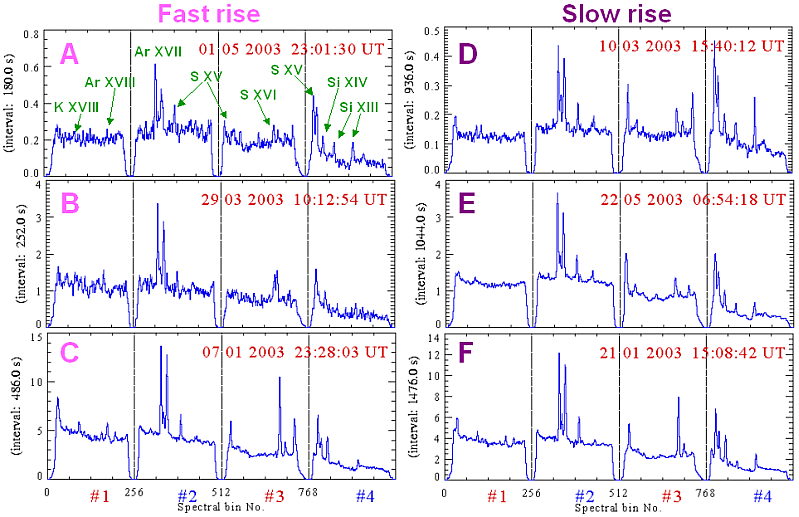RESIK & Diogeness NEWS
(Week 23, 2003, 02 Jun. - 08 Jun.)
In the display above (click to enlarge), the solar X-ray fluence seen by RESIK (black points) is plotted atop GOES red line. Only periods with good spectral measurements are indicated. The total number of good spectral measurements is given in the title line.
|
Operation mode: |
1 s DGI has been used.
|
|
|
Calibrations made: |
No calibrations made
| |
|
ADS Settings: |
| |
|
| ||
| (ORD1) HV: Det. A - 1480 V, Det. B - 1419 V. | (ORD3) HV: Det. A - 1389 V, Det. B - 1328 V. | ||||||
|
Channel |
l Band |
ADS |
Channel |
l Band |
ADS | ||
| #1 | #2 | 3.37 - 3.88 Å | 115 - 195 | #1 | #2 | 1.16 - 1.29 Å | 110 - 230 |
| #2 | #0 | 3.82 - 4.33 Å | 75 - 170 | #2 | #0 | 1.27 - 1.44 Å | 110 - 230 |
| #3 | #3 | 4.31 - 4.89 Å | 170 - 250 | #3 | #3 | 1.44 - 1.63 Å | 110 - 230 |
| #4 | #1 | 4.96 - 6.09 Å | 145 - 205 | #4 | #1 | 1.65 - 2.03 Å | 140 - 230 |
|
|
| ||||||
Data gaps due to missing/bad telemetry:
RESIK power was OFF starting May 23rd.
Note, that the link to the catalogue page is now: http://www.cbk.pan.wroc.pl/resik_catalogue.htm.
Spectra Observed During the Rise Phases of Flares
In the weekly archive one can find examples of RESIK observations for various individual events (7 Jan. 2003, 21 Jan. 2003, 10 Mar. 2003, 29 Mar. 2003, 1 May 2003, 22 May 2003). They differ in their intensities, locations on the solar disc and time profiles. The spectra observed during the rise and decay phases have been compared. Here we present the spectra of six flares as collected during their rise phases. We have chosen flares which are distinct in their rise phase duration. Three of selected flares are characterized by the short rise phase (3 – 8 min.) while the other three by longer one (21 – 27 min.). Table 1 gives the following characteristics for individual flares: date, the start, maximum and the end times, the duration of the rise phase, the GOES class and the location on the solar disc.
Table 1.The main characteristics of presented flares.
| Fast rise | |||||||
| Day | Start [UT] | Max [UT] | End [UT] | Rise duration [min.] | GOES class | Location | |
| A | 1 May 2003 | 23:00:00 | 23:03:00 | 23:07:00 |
3 |
C1.4 | S12W04 |
| B | 29 March 2003 | 10:11:00 | 10:15:00 | 10:25:00 | 4 | C7.2 | S13W14 |
| C | 7 January 2003 | 23:25:00 | 23:33:00 | 23:40:00 | 8 | M4.9 | S11E89 |
|
Slow rise |
|||||||
| Day | Start [UT] | Max [UT] | End [UT] | Rise duration [min.] | GOES class | Location | |
| D | 10 March 2003 | 15:31:00 | 15:53:00 | 16:12:00 | 22 | B9.7 | N12E39 |
| E | 22 May 2003 | 06:42:00 | 07:03:00 | 07:12:00 | 21 | C4.9 | S09W08 |
| F | 21 January 2003 | 14:59:00 | 15:26:00 | 15:52:00 | 27 | M1.9 | S07E90 |
Figure 1. A part of RESIK catalogue pages for selected flares. Left panel presents events characterised by the fast rise phase, right - flares with the slow rise. RESIK fluxes are plotted in green while red and blue lines correspond to GOES fluxes (for detailes see Legend 2003).

Figure 2. RESIK spectra integrated over the rise phase of selected flares. Only the main spectral features have been denoted. For the other lines identification see Weekly 40, 2002.
Inspection of the left and right panels in Figure 2 indicates that at the first glance presented spectra are very similar. There are no clearly defined differences between the relative intensities of individual lines in the spectra observed during the fast and slow rise phases of presented solar flares. However to state this for certain one needs to perform the detailed analysis of line fluxes. The quantitative analysis of the observed line fluxes requires to know the response function of the spectrometer (so-called effective area). The preliminary dependence of the RESIK effective area on the wavelength for the first order reflection has been presented in Weekly 14, 2003.
Prepared by: Anna Kepa ak@cbk.pan.wroc.pl and Barbara Sylwester bs@cbk.pan.wroc.pl
The report presented has been done in "real time" and so it may contain jargon, blunders, or trivialities. We do not have also an English native speaker in our Wroclaw group!
We would be happy to discuss problems mentioned above in more details if necessary.
RESIK data are in the open public domain and can be requested from: http://surfwww.mssl.ucl.ac.uk/surf/data_request.html.
Previous RESIK_weekly notes are in the archive: http://www.cbk.pan.wroc.pl/resik_archive.htm
Page made on 14 Jun 2003 by: Anna Kepa ak@cbk.pan.wroc.pl and Jarek Bakala jb@cbk.pan.wroc.pl